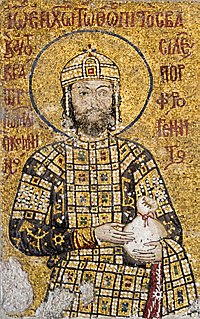| Byzantine army of the Komnenian period | |
|---|---|
 Emperor John II Komnenos, the most successful commander of the Komnenian army. | |
| Leaders | Byzantine Emperor |
| Dates of operation | 1081–1204 AD |
| Headquarters | Constantinople |
| Active regions | Anatolia, Southern Italy, Balkans, Hungary, Galicia, Crimea, Syria, Egypt. |
| Size | 50,000[1] (1143–1180) |
| Part of | Byzantine Empire |
| Allies | Venice, Genoa, Danishmends, Georgia, Galicia, Vladimir-Suzdal, Kiev, Ancona, Hungary, Jerusalem, Tripoli, Antioch, Mosul. |
| Opponents | Venice, Hungary, Danishmends, Bulgaria, Seljuks, Antioch, Sicily, Armenian Cilicia, Fatimids, Ayyubids, Pechenegs, Cumans. |
| Battles and wars | Dyrrhachium, Levounion, Nicaea Philomelion, Beroia, Haram, Shaizar, Constantinople (1147), Sirmium, Myriokephalon, Hyelion and Leimocheir, Demetritzes, Constantinople (1203), Constantinople (1204) |
The Byzantine army of the Komnenian era or Komnenian army[2] was a force established by Byzantine emperor Alexios I Komnenos during the late 11th/early 12th century. It was further developed during the 12th century by his successors John II Komnenos and Manuel I Komnenos. From necessity, following extensive territorial loss and a near disastrous defeat by the Normans of southern Italy at Dyrrachion in 1081, Alexios constructed a new army from the ground up. This new army was significantly different from previous forms of the Byzantine army, especially in the methods used for the recruitment and maintenance of soldiers. The army was characterised by an increased reliance on the military capabilities of the immediate imperial household, the relatives of the ruling dynasty and the provincial Byzantine aristocracy. Another distinctive element of the new army was an expansion of the employment of foreign mercenary troops and their organisation into more permanent units. However, continuity in equipment, unit organisation, tactics and strategy from earlier times is evident. The Komnenian army was instrumental in creating the territorial integrity and stability that allowed the Komnenian restoration of the Byzantine Empire. It was deployed in the Balkans, Italy, Hungary, Russia, Anatolia, Syria, the Holy Land and Egypt.